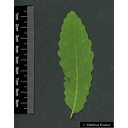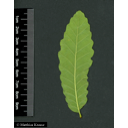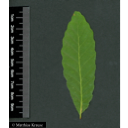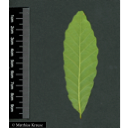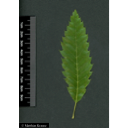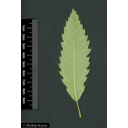Useful information about the taxon (species, subspecies, variety...)
Quercus libani Olivier 1801
Fagaceae
(APG IV)Lebanon oak
Taxon concept: The Plant List (2014), version 1.1
Distribution: Turkey, Syria, Iran, Iraq
Quercus libani Olivier - Accepted: Quercus libani Olivier bei Zander 2008; Familie: Fagaceae (Zander 2008)Quercus libani Olivier - Accepted: Quercus libani Olivier bei The Plant List (2014), version 1.1; Familie: Fagaceae (APG III)
- Flowers
- monoecious
- Flower ecology
- wind-pollinated (anemophilous)
- Life form
- tree
- Foliage persistence
- semi-evergreen
- Fruits
- seed (acorn) is green with a spiny cupule and 2.5 cm in diameter; acorns are very bitter due to high concentrations of tannins
- Fruit ecology
- gravity-dispersed (barochorous) and animal-dispersed (zoochorous)
- Soil conditions
- prefers dry or moist soil
- Natural occurrence (habitat)
- Mediterranean, montanous (oro-Mediterranean) forests and scrub, cedar forests (Cedrus libani forests)
- Vegetation typ and synecology (plant community)
- warm-temperate broad-leaved evergreen sclerophylluous forests; in associations of the Querco-Cedretalia
- Usage
- A mulch of the leaves acts as a repellent (e.g. against slugs), any galls produced on the tree are strongly astringent and can be used in the treatment of haemorrhages, chronic diarrhoea, dysentery etc., the roasted seed is a coffee substitute; wood is very hard and resistant to insect and fungal attack and is used in construction works; ornamental tree in gardens, parks
Erhardt, W., Götz, E., Bödeker, N. & Seybold, S. (2008): Der große Zander. Enzyklopädie der Pflanzennamen. Band 2. Arten und Sorten. Eugen Ulmer KG, Stuttgart (Hohenheim), 18. Aufl., 2103 S.; The International Plant Names Index (2009). Published on the Internet http://www.ipni.org; Courtesy to IPNI, 2009. Exported from IPNI at date: 2009-09-22 20:17:51;
Diese Webseite verwendet Google Maps, um Karten und Standorte von Pflanzen in den Hohenheimer Gärten anzuzeigen. Dadurch werden unter Umständen Daten an Google weitergeleitet, was mit einer Verarbeitung Ihrer personenbezogenen Daten verbunden sein kann. Die Datenschutzerklärung von Google finden Sie hier: Datenschutzerklärung von Google
| Sex | Standort | Accession number | Planting year | Donation | IPEN | Lat. | Long. |
|---|---|---|---|---|---|---|---|
| Parzelle A | EG-A-023-17172 | 1974 | XX-0-HOH-EG-A-023-17172 | 48,7105558136 | 9,2049563022 | ||
| Parzelle N | SP-NB-118-17032 | 2016 | XX-0-HOH-SP-NB-118-17032 | 48,7116952654 | 9,2166517387 |

